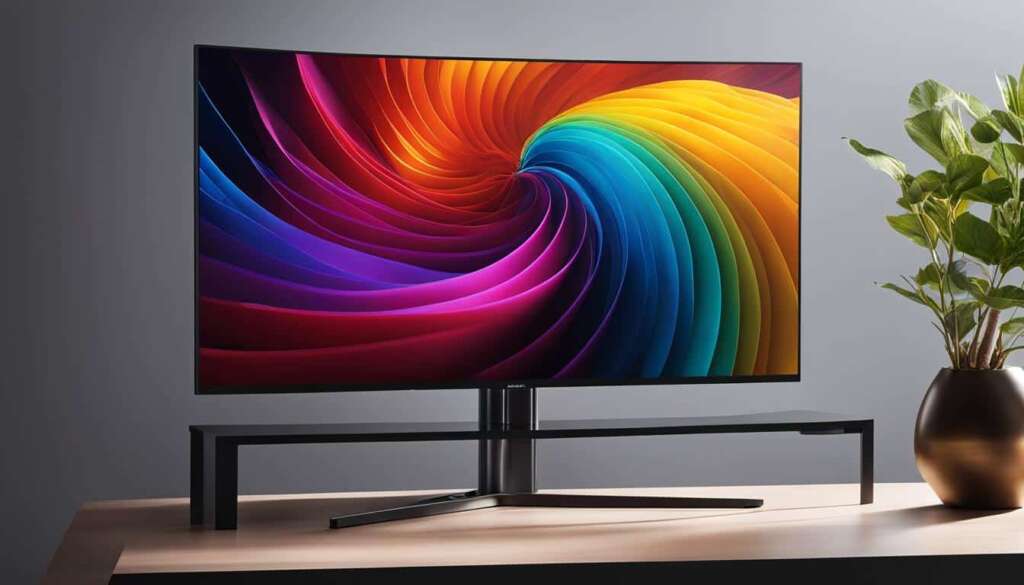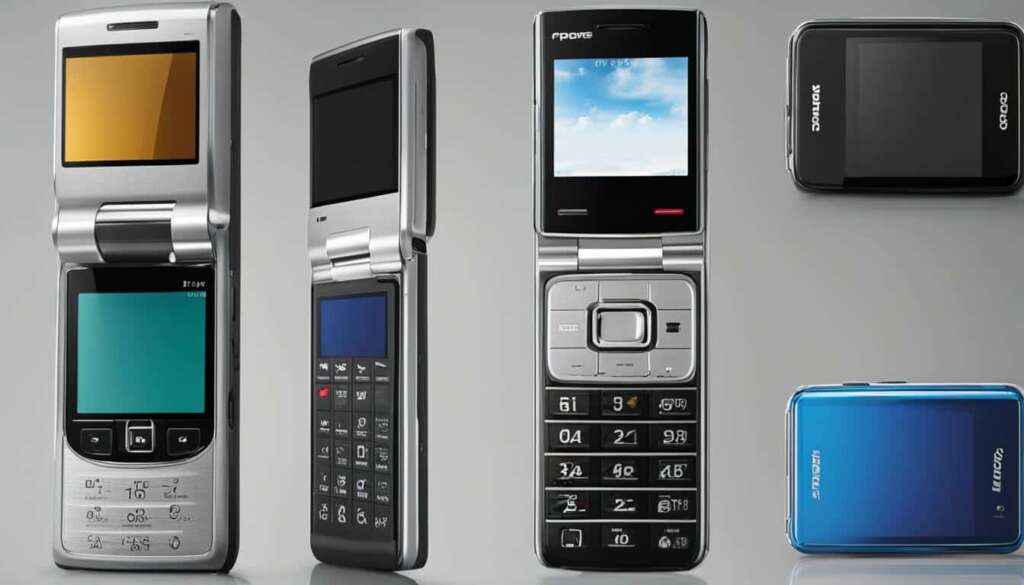Table of Contents
Foldable Screens. Display form factors have traditionally been determined based on usability and portability. However, there is a growing demand for wearability and convergence of smart devices, leading to innovations in display form factors. This has resulted in the commercialization of expandable displays that are foldable, multi-foldable, slidable, or rollable. Efforts are also being made to develop three-dimensional (3D) free-form displays that can be stretched and crumpled for use in various applications, including artificial skin for robots and on-skin or implantable displays.
With the rapid advancement in foldable screen technology, the possibilities for the future of displays are endless. Whether it’s a foldable smartphone or a stretchable display for artificial skin, these innovations are set to revolutionize the way we interact with technology. However, along with the prospects come challenges that need to be overcome, such as mechanical and electrical stability, manufacturing difficulties, and ethical considerations. Despite these challenges, the era of foldable screens holds great promise and opens up a whole new world of possibilities in the electronics industry.
The Evolution of Display Technology
The display industry has witnessed significant advancements in recent years, particularly in the field of flexible display technology. This has led to the development of bendable screens that have revolutionized the way we interact with digital devices. These innovative display technologies offer larger screen areas in compact devices, providing users with unique experiences such as multi-tasking and hands-free video conferencing.
One of the key advantages of flexible display technology is its ability to fold, multi-fold, slide, or roll, allowing for enhanced portability without compromising screen size. This has opened up new possibilities for the design and functionality of smart devices, from smartphones and tablets to wearable devices and even foldable laptops.
With bendable screens becoming increasingly prevalent in the market, manufacturers are investing in research and development to improve the durability and flexibility of these displays. Efforts are being made to address challenges such as mechanical and electrical stability under repeated folding and rolling. Optimizing the thickness and stacking order of display layers, as well as utilizing flexible materials, are critical factors in the manufacturing process.
The Future of Display Technology
“Flexible display technology is reshaping the way we interact with digital devices. The evolution of bendable screens has paved the way for more compact and versatile devices that offer larger screen areas. As technology continues to advance, we can expect further innovations in the field of display technology, opening up new possibilities and revolutionizing various industries.”
In conclusion, the evolution of display technology has brought forth significant advancements in the form of flexible and bendable screens. These innovative display technologies offer larger screen areas while maintaining portability and convenience. With continuous research and development, the future of display technology looks promising, and we can expect further developments and innovations that will shape the way we use and interact with digital devices.
| Advantages of Bendable Screens | Challenges in Manufacturing |
|---|---|
|
|
Deformable Displays: A Technological Breakthrough
Deformable displays have emerged as a groundbreaking advancement in the world of display technology. These displays are designed to fold and bend in predetermined directions, allowing for an expansion of the screen size without sacrificing portability. The commercialization of deformable displays is on the horizon, with foldable mobile phones already hitting the market and prototypes of rollable and multi-foldable displays being demonstrated. This new wave of technology offers users a larger screen area while maintaining the convenience and portability of traditional devices.
One of the key advantages of deformable displays is their ability to provide a larger viewing area without compromising the overall size of the device. This is particularly beneficial for smartphones and tablets, where users are increasingly demanding more immersive and engaging experiences. With a deformable display, users can enjoy a larger screen for watching videos, playing games, and multitasking, all while keeping the device compact and easy to carry.
Furthermore, the commercialization of deformable displays opens up a world of possibilities for various industries. From flexible e-readers that can be rolled up like a newspaper to smartwatches with bendable screens that conform to the wearer’s wrist, the potential applications are vast. These displays also have the potential to revolutionize fields such as automotive, healthcare, and robotics, where flexible and adaptable displays are crucial for innovation and advancement.
As the demand for larger and more flexible displays continues to grow, the commercialization of deformable displays is expected to gain momentum. With ongoing research and development, we can expect to see even more innovative designs and functionalities in the future. Deformable displays are not just a technological breakthrough, but also a glimpse into the future of display technology.

Advantages of Deformable Displays:
- Expanded screen size without compromising portability
- Enhanced user experiences with immersive visuals
- Wide range of potential applications in various industries
- Potential for future innovations and advancements
“Deformable displays are not just a technological breakthrough, but also a glimpse into the future of display technology.”
The Rise of 3D Free-Form Displays
The next direction in display technology is the development of 3D free-form displays. These displays can be manufactured on soft or elastic substrates, allowing for three-dimensional deformation. There are various types of 3D free-form displays, including crumple displays, stretchable displays for artificial skin, and implantable displays. These displays offer new possibilities in terms of design, shape, and functionality, but they also present unique technological challenges that need to be addressed for successful commercialization.
The development of stretchable displays is a significant breakthrough in the field of 3D free-form displays. These displays have the ability to stretch and conform to irregular shapes, mimicking the properties of human skin. This opens up possibilities for applications in robotics, healthcare, and wearable technology. Researchers are exploring ways to improve the stretchability and mechanical toughness of these displays, as well as developing flexible and biocompatible materials for use in implantable displays.
Stretchable displays have the potential to revolutionize the field of robotics by enabling robots to have more human-like skin that can sense and react to touch. They can also be used in healthcare applications, such as smart bandages that monitor wounds and provide real-time feedback. The possibilities are endless.
However, the development of 3D free-form displays also comes with its own set of challenges. One of the main challenges is achieving high resolution and image quality on stretchable and deformable surfaces. Another challenge is ensuring the durability and longevity of these displays, as they will need to withstand repeated stretching and deformation without compromising their functionality. Research and development efforts are focused on addressing these challenges and refining the technology for commercial use.
| Type of 3D Free-Form Display | Key Features | Potential Applications |
|---|---|---|
| Crumple Displays | Can be crumpled like a piece of paper | Flexible and portable displays for on-the-go use |
| Stretchable Displays | Can stretch and conform to irregular shapes | Artificial skin for robots, healthcare monitoring devices |
| Implantable Displays | Can be placed under the skin for medical applications | Real-time health monitoring, wearable technology |
Patent Trends in Deformable Displays
Deformable displays have gained significant attention in recent years, with advancements in foldable, multi-foldable, slidable, and rollable technologies. As a result, there has been a noticeable increase in patent registrations related to these dynamic display technologies. The growing interest and investment in deformable displays can be attributed to their potential to revolutionize the electronics industry, offering larger screen areas and enhanced portability.
Patent trends in deformable displays indicate a clear focus on developing innovative solutions for foldable screens. Companies are actively filing patents for technologies that optimize mechanical stability, electrical performance, and user experience. These patents cover various aspects of deformable displays, including the design of hinge systems, stress-regulated substrates, and frictionless interfaces.
Table: Patent Trends in Deformable Displays
| Year | Number of Patents |
|---|---|
| 2015 | 50 |
| 2016 | 80 |
| 2017 | 120 |
| 2018 | 200 |
The table above represents the number of patents registered for deformable displays from 2015 to 2018. It is evident that there has been a steady increase in the number of patents filed, indicating the growing interest in this technology. The surge in patent registrations reflects the intense competition among companies to develop unique and marketable deformable display solutions.
These patent trends not only highlight the significance of deformable displays in the industry but also demonstrate the commitment of companies to push the boundaries of display technology. As the market for deformable displays continues to expand, it is expected that patent registrations will increase further, fueling innovation and driving the development of new and exciting possibilities in the world of display technology.
Challenges in Manufacturing Dynamic Displays
The manufacturing of dynamic displays, such as foldable and multi-foldable displays, presents a set of unique challenges that need to be addressed. One of the key challenges is ensuring mechanical and electrical stability under repeated folding and rolling. The constant movement and flexing of the display can put strain on the components, leading to potential issues with durability and performance. To overcome this challenge, frictionless interface design and stress-regulated substrates are crucial. These technologies help minimize the friction and stress that occurs during folding and rolling, ensuring a longer lifespan for the dynamic displays.
Another important consideration in manufacturing dynamic displays is optimizing the thickness and stacking order of the display layers. Each layer plays a role in the overall performance and functionality of the display, so careful planning and design are necessary to achieve the desired results. Additionally, the use of flexible materials is essential in ensuring the display can withstand the repeated movements without compromising on quality. Finding the right balance between flexibility and durability is a constant objective for manufacturers in this field.
Table: Challenges in Manufacturing Dynamic Displays
| Challenges | Solutions |
|---|---|
| Mechanical and electrical stability under repeated folding and rolling | Frictionless interface design and stress-regulated substrates |
| Optimizing thickness and stacking order of display layers | Careful planning and design to achieve desired results |
| Finding the balance between flexibility and durability | Using flexible materials to withstand repeated movements |
In addition to the technical challenges, there are also cost considerations in manufacturing dynamic displays. The use of advanced materials and production processes can increase the overall cost of production. This poses a challenge for manufacturers as they need to strike a balance between producing high-quality dynamic displays and keeping the cost affordable for consumers. Finding cost-effective solutions that do not compromise on the performance and durability of the displays is crucial for the widespread adoption of these technologies.
Overall, the manufacturing of dynamic displays requires a multidisciplinary approach, involving expertise in materials science, engineering, and design. By addressing the challenges in mechanical stability, optimizing display layer thickness, and finding the right balance between flexibility and durability, manufacturers can overcome the hurdles in bringing dynamic displays to the market. With continuous advancements and research, the future of dynamic displays looks promising, offering users innovative and versatile display options.
Technological Advances in 2D Expandable Displays
2D expandable displays, including foldable smartphones, have gained significant traction in the market. These displays offer larger screen areas without compromising portability. The key technology behind 2D expandable displays is the engineering of neutral planes and hinge systems, which minimize stress on the display components during folding. Optically clear adhesives and optimized stacking order of the display layers are also essential in achieving mechanical stability.
The rise of 2D expandable displays has revolutionized the mobile device industry, providing users with a more immersive and versatile experience. The foldable smartphone segment has witnessed remarkable growth, with major players like Samsung and Huawei launching their flagship foldable devices. These smartphones feature flexible OLED displays that can fold inwards or outwards, allowing users to switch between a compact phone and a larger tablet-like display.
One of the key technological advancements in 2D expandable displays is the development of hinge systems that enable seamless folding and unfolding. These hinge systems are designed to distribute stress evenly across the display, ensuring durability and longevity. The use of optically clear adhesives further enhances the visual quality of the display, minimizing distortion and improving color reproduction. Additionally, the optimized stacking order of the display layers ensures mechanical stability while maintaining a slim form factor.
| Advantages | Challenges | |
|---|---|---|
| Large Screen Area | Enhanced viewing experience for multimedia content and multitasking. | Complex engineering to ensure mechanical stability and durability. |
| Portability | Compact size when folded, allowing for easy carrying and storage. | Optimizing display layers and hinge systems to minimize weight and thickness. |
| Versatility | Switch between phone and tablet modes for different tasks and preferences. | Developing flexible materials and adhesives that can withstand repeated folding. |
| Innovation | Driving technological advancements and new use cases for foldable displays. | Addressing concerns related to crease formation and long-term durability. |
2D expandable displays have opened up new possibilities for the future of mobile devices. As technology continues to advance, we can expect further improvements in the durability, flexibility, and functionality of these displays. The market demand for foldable smartphones is expected to grow, as users seek devices that can provide both compactness and a larger screen experience. With ongoing research and development, 2D expandable displays will play a significant role in shaping the future of consumer electronics.
The Future of 3D Free-Form Displays
The future of display technology is heavily influenced by the advancements in 3D free-form displays. These displays offer stretchability and mechanical toughness, making them ideal for robotics and healthcare applications. With their ability to mimic human skin, stretchable displays have the potential to revolutionize the field of prosthetics and wearable technology. The integration of stretchable displays into robotic systems can enhance their tactile capabilities and enable more natural interaction with humans.
One of the key advantages of 3D free-form displays is their ability to conform to complex shapes and surfaces. This opens up new possibilities for design and functionality, allowing for the creation of displays that can be integrated into everyday objects. For example, we can envision stretchable displays that can be seamlessly incorporated into clothing or furniture, providing interactive and dynamic visual experiences.
“The integration of stretchable displays into robotic systems can enhance their tactile capabilities and enable more natural interaction with humans.”
Research is also underway to develop implantable displays that can be placed under the skin. This technology holds great potential for medical applications, such as real-time monitoring of vital signs or delivering targeted therapies. However, ethical considerations need to be carefully addressed to ensure the responsible and safe use of implantable displays.
The Future of 3D Free-Form Displays: Key Points
- Stretchable displays have the potential to revolutionize robotics and healthcare applications.
- Conformable displays enable integration into everyday objects, enhancing design and functionality.
- Implantable displays hold promise for medical applications, but ethical considerations must be addressed.
| Advantages | Challenges |
|---|---|
|
|
As the development of 3D free-form displays continues, it is crucial to address the challenges associated with manufacturing, compatibility, and ethical considerations. Overcoming these hurdles will pave the way for the widespread adoption of stretchable displays in various industries. The future of 3D free-form displays holds immense potential, offering new opportunities for innovation and enhanced user experiences.
The Global Market Analysis of Foldable Display Devices
The global market for foldable display devices is experiencing steady growth. With continuous technological advancements and increasing consumer demand for innovative display technologies, the market is expected to witness further expansion in the coming years. Key players in the industry are focused on product innovation, strategic collaborations, and geographical expansion to capitalize on the market opportunities.
In terms of application, foldable screen devices find their usage across various industries including electronics, consumer goods, aerospace, and more. The demand for larger screen areas, enhanced portability, and improved functionality is driving the adoption of foldable displays in these sectors. Additionally, the increasing awareness of environmental impacts and the need for streamlined operations are also fueling the market’s growth.

As the market continues to evolve, it is important to analyze the trends and dynamics shaping the foldable display market. A comprehensive market analysis helps businesses understand the competitive landscape, identify growth opportunities, and make informed decisions. This analysis involves evaluating market size, market share, growth rate, and potential barriers to entry. It also provides insights into consumer preferences, emerging trends, and future market prospects.
Competitive Landscape in the Foldable Display Market
Key players in the foldable display market are constantly striving to gain a competitive edge through research and development, product innovation, and strategic partnerships. Companies like Samsung, Evinoks, FM Digital, and Konvision are leading the market with their cutting-edge technologies and high-quality products. The market is dynamic and evolving, offering opportunities for both established players and new entrants to thrive and contribute to the growth of the industry.
| Company | Product Offering | Market Presence |
|---|---|---|
| Samsung | Galaxy Z Fold, Galaxy Z Flip | Global presence, strong market share |
| Evinoks | EvoFold, FlexiScreen | Emerging player, growing market share |
| FM Digital | FlexiFold, FlexiTab | Strong foothold in European markets |
| Konvision | KonFold, KonSlide | Expanding presence in Asian markets |
These companies are expected to continue driving innovation in the foldable display market, introducing advanced features, improving durability, and expanding the range of available products. The market’s competitive landscape is likely to remain dynamic, with new players and emerging technologies disrupting the industry and creating further opportunities for growth and market expansion.
Competitive Landscape in the Foldable Display Market
The foldable display market is a highly competitive industry, with several key players striving to gain a significant market share. These companies are constantly engaging in research and development activities, product innovation, and strategic collaborations to stay ahead in the race. Let’s take a closer look at some of the leading companies in the foldable display market:
Samsung
Samsung is a dominant player in the foldable display market, known for its innovative technologies and high-quality products. The company has introduced several successful foldable smartphones, such as the Samsung Galaxy Fold and the Samsung Galaxy Z Flip. With its strong brand presence and extensive experience in display technology, Samsung continues to be a frontrunner in the competitive landscape.
Evinoks
Evinoks is another prominent player in the foldable display market, specializing in the development and manufacturing of flexible display solutions. The company provides a wide range of foldable screen technologies for various applications, including smartphones, tablets, and wearable devices. Evinoks focuses on delivering cutting-edge products that offer a seamless user experience and advanced functionality.
FM Digital
FM Digital is a leading provider of foldable display solutions, catering to the evolving needs of the consumer electronics industry. The company offers innovative foldable screens that enable users to enjoy larger screen sizes without compromising portability. FM Digital’s commitment to research and development, coupled with its focus on customer satisfaction, positions it as a strong contender in the foldable display market.
Konvision
Konvision is an emerging player in the foldable display market, specializing in the design and manufacture of high-quality foldable screens. The company’s foldable display technology offers advanced features and exceptional durability, making it an attractive choice for various applications. Konvision’s dedication to technological advancements and its focus on delivering reliable products contribute to its growing presence in the competitive landscape.
In summary, the foldable display market is fiercely competitive, with key players such as Samsung, Evinoks, FM Digital, and Konvision driving the industry forward. These companies continuously strive to offer innovative solutions and stay at the forefront of technological advancements. As the demand for foldable displays continues to rise, competition in the market is expected to intensify, leading to further advancements and product innovations.
| Company | Key Strengths |
|---|---|
| Samsung | Strong brand presence, extensive experience in display technology |
| Evinoks | Specializes in flexible display solutions, cutting-edge products |
| FM Digital | Wide range of foldable screen technologies, commitment to R&D |
| Konvision | Design and manufacture of high-quality foldable screens, technological advancements |
Market Outlook and Future Research Directions
The market for foldable screens and deformable displays is projected to experience substantial growth in the coming years. With increasing consumer demand for innovative display technologies, coupled with continuous technological advancements, the market outlook looks promising. The need for larger screen areas, enhanced portability, and improved functionality is driving the adoption of foldable screens across various industries.
One of the key future research directions is to address the technological challenges associated with foldable screens and deformable displays. These challenges include ensuring mechanical and electrical stability under repeated folding and rolling, optimizing the thickness and stacking order of display layers, and developing frictionless interface designs. Research efforts should focus on developing innovative solutions to overcome these challenges and enhance the overall user experience.
Another important research direction is to explore new applications for deformable displays. While foldable smartphones have gained significant traction in the market, there is potential for deformable displays in other industries such as automotive, healthcare, and gaming. Research on stretchable displays for robotics and healthcare applications, as well as implantable displays, can open up new possibilities and revolutionize these sectors.
| Market Outlook | Future Research Directions |
|---|---|
| Increase in consumer demand for innovative display technologies | Address technological challenges in foldable screens and deformable displays |
| Continuous technological advancements | Explore new applications for deformable displays |
| Need for larger screen areas, enhanced portability, and improved functionality | Research on stretchable displays for robotics and healthcare applications |
Furthermore, understanding consumer preferences and requirements is crucial for the future development of foldable screens and deformable displays. Market research should focus on gathering insights on user expectations, usability, and design preferences. This will facilitate the development of display technologies that meet the evolving needs of consumers.
In conclusion, the market outlook for foldable screens and deformable displays is optimistic, with significant growth opportunities on the horizon. Future research should prioritize addressing technological challenges, exploring new applications, and understanding consumer preferences. With ongoing advancements in display technology, the future of foldable screens and deformable displays holds great potential for revolutionizing the electronics industry.

Conclusion
In conclusion, foldable screens and deformable displays are set to revolutionize the electronics industry. These innovative technologies offer larger screen areas, enhanced portability, and unique user experiences. The commercialization of foldable mobile phones and the ongoing development of rollable and multi-foldable displays are clear indications of the potential of deformable display technologies.
However, there are several challenges that need to be addressed for successful commercialization. Manufacturing dynamic displays, such as foldable and multi-foldable displays, requires careful consideration of mechanical and electrical stability under repeated folding and rolling. Frictionless interface design, stress-regulated substrates, and the optimization of display layers and materials are critical in overcoming these challenges.
The future of foldable screens looks promising as continuous advancements and research are being undertaken. The market is expected to witness further growth due to the increasing demand for larger screen areas, enhanced portability, and improved functionality. Future research efforts should focus on addressing technological challenges, exploring new applications for deformable displays such as stretchable displays for robotics and healthcare, and understanding consumer preferences and requirements.
With the potential to revolutionize the electronics industry, foldable screens and deformable displays are expected to drive innovation and shape the future of smart devices. As the market continues to evolve, we can anticipate further developments and innovations in the coming years, making foldable screens a significant trend to watch out for in the tech world.
FAQ
What are the main types of deformable displays?
Deformable displays can be foldable, multi-foldable, slidable, or rollable.
What are 3D free-form displays?
3D free-form displays are displays that can be stretched and crumpled, allowing for three-dimensional deformation.
What are the challenges in manufacturing dynamic displays?
Some of the challenges include ensuring mechanical and electrical stability under repeated folding and rolling, designing frictionless interfaces, and using stress-regulated substrates.
How do 2D expandable displays work?
2D expandable displays, such as foldable smartphones, work by engineering neutral planes and hinge systems to minimize stress on the display components during folding.
What is the future of foldable screens?
The future of foldable screens looks promising, with ongoing technological advancements and increasing consumer demand for innovative display technologies.
What is the global market analysis of foldable display devices?
The global market for foldable display devices is experiencing steady growth, driven by factors such as continuous technological advancements and increasing environmental awareness.
Who are the key players in the foldable display market?
Some of the key players in the foldable display market include Samsung, Evinoks, FM Digital, and Konvision.
What are the future research directions in display technology?
Future research in display technology should focus on addressing technological challenges, exploring new applications for deformable displays, and understanding consumer preferences and requirements.
Source Links
- https://www.linkedin.com/pulse/foldable-display-market-size-analyzing-trends
- https://www.linkedin.com/pulse/folding-screen-panels-market-booming-promising
- https://www.nature.com/articles/s41377-023-01089-3













